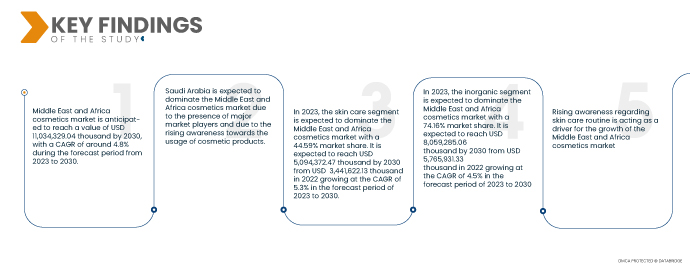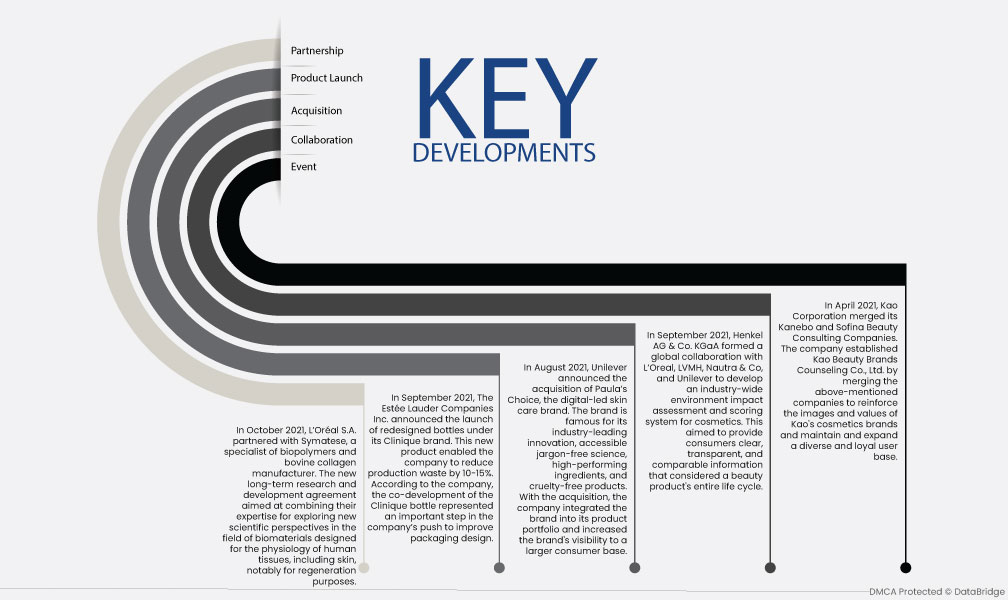Cosmetics are largely designed to be used or applied to enhance a personage's beauty and physical appearance. Chiefly, these cosmetic products are manufactured from artificial sources. Cosmetic products are mainly intended for external cleaning, perfumes, changing appearances, correcting body odor, protecting skin, and conditioning. Ranging from antiperspirants, fragrances, make up, and shampoos to soaps, sunscreens, toothpaste, cosmetics, and personal care products are essential in all consumer life stages. Cosmetics are manufactured using mixtures of chemical compounds; these compounds are either derived from natural sources or are artificial.
Access full Report @ https://www.databridgemarketresearch.com/reports/middle-east-and-africa-cosmetics-market
Data Bridge Market Research analyzes that the Middle East and Africa Cosmetics Market is expected to grow with a CAGR of 4.8% from 2023 to 2030 and is expected to reach USD 11,034,329.04 thousand by 2030.
Key Findings of the Study
Rising awareness regarding skin care routine
The cosmetics market has benefitted from the renewed focus on hygiene and self-care routines. The increasing demand for self-care products to combat stress & anxiety, and the tendency of consumers to increase their engagement in self-care routines to feel good and look better, has been the major driver for the cosmetics market. The interest in natural and organic ingredients has further increase the awareness and demand for skin care products such as face masks, body scrubs, toners, and serum among the users, as it emphasizes changing their existing skin care.
The focus of the skin care industry has been on women, and the market was infused with women-centric products for the longest time. The major factors leading to market growth include surging scrutiny of product ingredients, new product launches, and the addition of an anti-aging range in the skin care segment. The increase in awareness among the Middle East and Africa populations about innovative cosmetics products for skin care and hygiene can be largely attributed to social media increasing the reach to the vast audience.
Thus, the increase in awareness of skin care routines among consumers due to the change in lifestyle and the increased reach to product information due to social media is proving to be a major driver for the market's growth.
Report Scope and Market Segmentation
|
Report Metric
|
Details
|
|
Forecast Period
|
2023 to 2030
|
|
Base Year
|
2022
|
|
Historic Years
|
2021 (Customizable to 2015 - 2020)
|
|
Quantitative Units
|
Revenue in USD Thousand
|
|
Segments Covered
|
Product Type (Skin Care, Hair Care, Make Up, Fragrances, and Others), Nature (Inorganic and Organic), Category (Mass Product, Premium Product, and Professional Product), Packaging Type (Bottles and Jars, Tubes, Containers, Pumps and Dispensers, Sticks, Aerosol Cans, Pouches, and Blisters & Strip Packs), Distribution Channel (Offline and Online), Application (Women and Men)
|
|
Countries Covered
|
Saudi Arabia, United Arab Emirates, Egypt, Israel, South Africa, and Rest of Middle East and Africa
|
|
Market Players Covered
|
Procter & Gamble (U.S.), L’Oréal S.A. (France), The Estée Lauder Companies Inc. (U.S.), Coty Inc. (U.S.), Shiseido Company, Limited (Japan), Colgate-Palmolive Company (U.S.), Kao Corporation (Japan), Beiersdorf Group (Germany), Unilever (U.K.), Revlon, Inc. (U.S.), and Henkel AG & Co. KGaA (Germany) among others
|
|
Data Points Covered in the Report
|
In addition to the insights on market scenarios such as market value, growth rate, segmentation, geographical coverage, and major players, the market reports curated by the Data Bridge Market Research also include depth expert analysis, material handling and storage, transport and precautions, and hazard identification.
|
Segment Analysis
The Middle East and Africa cosmetics market is segmented into six notable segments based on product type, nature, category, packaging type, distribution channel, and application.
- Based on product type, the market is segmented into skin care, hair care, make up, fragrances, and others.
In 2023, the skin care segment of product type is anticipated to dominate the Middle East and Africa cosmetics market
In 2023, the skin care segment is expected to dominate the Middle East and Africa cosmetics market with a 44.59% market share as consumers become more concerned about their healthy skin. Social media has also played an essential role in advertising skincare brands.
- Based on nature, the market is segmented into inorganic and organic. In 2023, the inorganic segment is expected to dominate the market with a 74.16% market share as these products are highly effective. Hair colors, anti-acne creams, anti-wrinkle creams, and other products are manufactured with inorganic ingredients to enhance their outcome.
- Based on category, the market is segmented into mass product, premium product, and professional product. In 2023, the mass product segment is expected to dominate the market with a 42.16% market share due to its wide product range, distribution network, and affordable prices. Cosmetic products are being manufactured in mass due to increasing demand in the market.
- Based on packaging type, the market is segmented into bottles and jars, tubes, containers, Pouches, sticks, pumps and dispensers, blisters and strip packs, and aerosol cans. In 2023, the bottles and jars segment is expected to dominate the market with a 30.62% market share as jars come in various sizes. Bottles are good for liquid products that consumers want to be dispensed by a particular method (pump or sprayer) and want larger volumes.
- Based on distribution channel, the market is segmented into offline and online. In 2023, the offline segment is expected to dominate the market with a 70.48% market share as it is a traditional form of distribution channel focusing on bricks and mortar, with its sales through supermarkets, specialty stores, pharmacies, and salons. Customers can get various options, suggestions, and samples through these stores that improve their decision-making.
- Based on application, the market is segmented into women and men.
In 2023, the women segment of application is anticipated to dominate the Middle East and Africa cosmetics market.
In 2023, the women segment is expected to dominate the market with a 73.53% market share as the market is highly women-centric, with a wide range of products available for women's beauty. Moreover, with the increasing use of social media, women's demand for beauty products has increased.
Major Players
Data Bridge Market Research recognizes the following companies as the major players in the Middle East and Africa cosmetics market that includes Procter & Gamble (U.S.), L’Oréal S.A. (France), The Estée Lauder Companies Inc. (U.S.), Coty Inc. (U.S.), Shiseido Company, Limited (Japan), Colgate-Palmolive Company (U.S.), Kao Corporation (Japan), Beiersdorf Group (Germany), Unilever (U.K.), Revlon, Inc. (U.S.), and Henkel AG & Co. KGaA (Germany) among others.
Market Developments
- In October 2021, L’Oréal S.A. partnered with Symatese, a specialist of biopolymers and bovine collagen manufacturer. The new long-term research and development agreement aimed at combining their expertise for exploring new scientific perspectives in the field of biomaterials designed for the physiology of human tissues, including skin, notably for regeneration purposes.
- In September 2021, The Estée Lauder Companies Inc. announced the launch of redesigned bottles under its Clinique brand. This new product enabled the company to reduce production waste by 10-15%. According to the company, the co-development of the Clinique bottle represented an important step in the company’s push to improve packaging design.
- In August 2021, Unilever announced the acquisition of Paula’s Choice, the digital-led skin care brand. The brand is famous for its industry-leading innovation, accessible jargon-free science, high-performing ingredients, and cruelty-free products. With the acquisition, the company integrated the brand into its product portfolio and increased its visibility to a larger consumer base.
- In September 2021, Henkel AG & Co. KGaA formed a global collaboration with L’Oreal, LVMH, Nautra & Co, and Unilever to develop an industry-wide environment impact assessment and scoring system for cosmetics. This aimed to provide consumers clear, transparent, and comparable information that considered a beauty product's entire life cycleRegional Analysis.
- In April 2021, Kao Corporation merged its Kanebo and Sofina Beauty Consulting Companies. The company established Kao Beauty Brands Counseling Co., Ltd. by merging the above-mentioned companies to reinforce the images and values of Kao's cosmetics brands and maintain and expand a diverse and loyal user base.
Geographically, the countries covered in the Middle East and Africa cosmetics market report are Saudi Arabia, United Arab Emirates, Egypt, Israel, South Africa, and Rest of Middle East and Africa.
As per Data Bridge Market Research analysis:
Saudi Arabia is the dominant country in the Middle East and Africa cosmetics market
Saudi Arabia is expected to dominate the Middle East and Africa cosmetics market due to the increasing need for cosmetics in the country. Saudi Arabia will continue to dominate the Middle East and Africa cosmetics market in terms of market share and market revenue. It will continue to flourish its dominance during the forecast period due to a large consumer base and the presence of top market players in the country.
Saudi Arabia is estimated to be the fastest-growing country in the Middle East and Africa cosmetics market for the forecast period 2023-2030
Saudi Arabia is expected to grow during the forecast period due to its diversity and dynamic market range, with enormous demands for various products.
For more detailed information about the Middle East and Africa cosmetics market report, click here – https://www.databridgemarketresearch.com/reports/middle-east-and-africa-cosmetics-market












